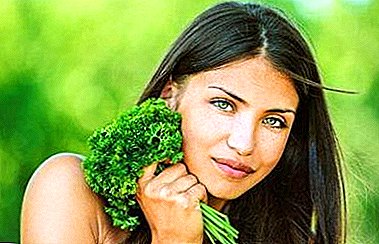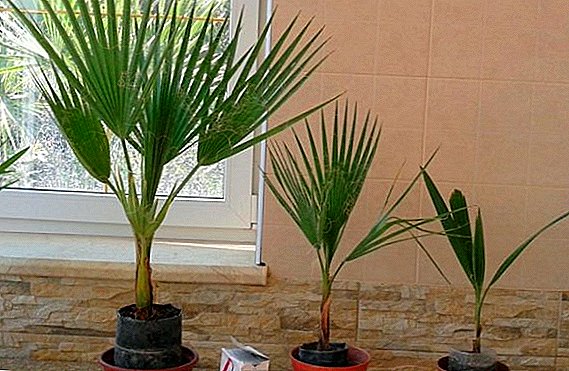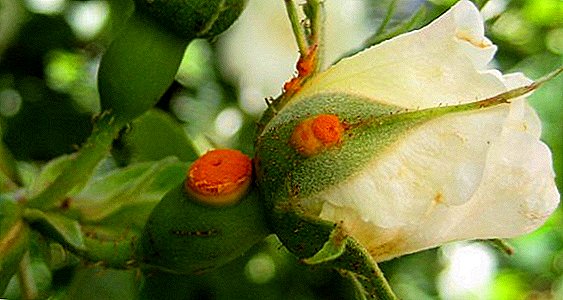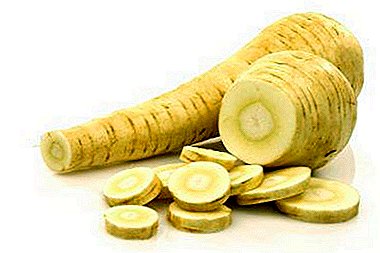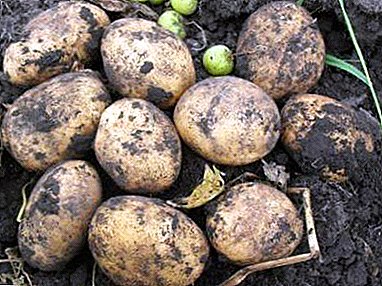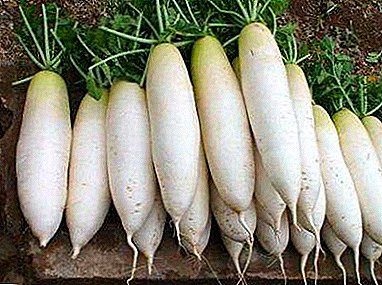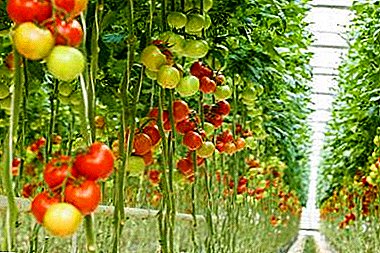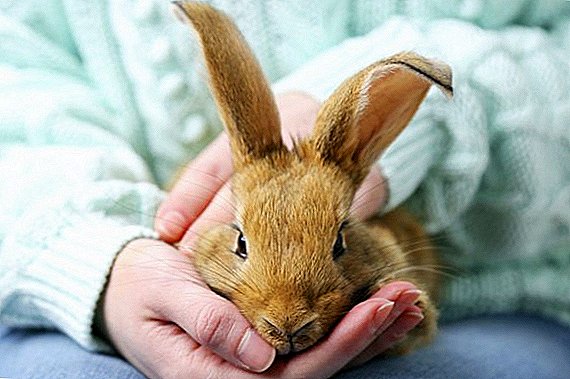 The diet of domestic rabbits can not be called balanced without sufficient intake of vitamin substances. For normal functioning of the body, they are needed in very small quantities, but even the slightest shortage of them can lead to significant disability.
The diet of domestic rabbits can not be called balanced without sufficient intake of vitamin substances. For normal functioning of the body, they are needed in very small quantities, but even the slightest shortage of them can lead to significant disability.
The problem is that hypovitaminosis does not appear immediately, and an inexperienced breeder may not notice its signs in rabbits at all. In order to prevent a dangerous state, it is important to know which vitamins are necessary for rabbits, as well as which products and preparations can replenish their stock.
What vitamins should be given to rabbits
Rabbits need a full range of vitamin substances, because each of them affects and regulates certain processes in the body. Due to the fact that the body is not able to synthesize vitamin substances on their own, they must constantly come from food or as supplements.  However, even those species that the body itself synthesizes are able to be produced in the intestine only if the microflora is of the correct composition and the normal functioning of the digestive system. Therefore, as a preventive measure, animals should be given vitamin complexes containing the full range of necessary substances.
However, even those species that the body itself synthesizes are able to be produced in the intestine only if the microflora is of the correct composition and the normal functioning of the digestive system. Therefore, as a preventive measure, animals should be given vitamin complexes containing the full range of necessary substances.
List of essential vitamins
The main types of vitamins that must be present in the diet of animals:
Did you know? Vitamin B in powder form is often used in the cinema, when heroes need to imitate the use of narcotic substances.
| Vitamins | Benefit |
| BUT | Responsible for the normal state and work of the respiratory, digestive, reproductive systems, the condition of the skin, is involved in metabolic processes and the synthesis of a number of hormones; |
| WITH | Regulates the work of immunity, digestive system, metabolic and redox processes, is an antioxidant, protects the body from the effects of toxins and poisons, affects the production of steroid hormones; |
| E | It participates in protein and carbohydrate metabolism, regulates metabolism and makes it possible to bear a fetus in females, in males it is responsible for the normal condition of the seminiferous tubules, takes part in the synthesis of other vitamins, acts as an antioxidant. |
| D | Responsible for the absorption of calcium, because it depends on the state of the musculoskeletal system. Also affects protein and carbohydrate metabolism, the work of the endocrine glands; |
| IN 1 | Regulates metabolic processes, is responsible for the synthesis of fatty acids; |
| AT 2 | Participates in the production of enzymes, regulates redox processes at the cellular level, provides normal metabolic processes, regulates the normal functioning of the visual, reproductive, nervous systems; |
| AT 4 | Responsible for the functioning of the nervous system and lipid metabolism, supports the proper functioning of the liver; |
| AT 5 | Participates in protein, carbohydrate and fat metabolism, ensures the normal functioning of tissues, body growth and hair pigmentation; |
| AT 6 | It is responsible for the synthesis of fatty acids and certain amino acids, ensures all metabolic processes of the body; |
| AT 9 | Responsible for the formation of leukocytes and red blood cells; |
| AT 12 | Takes part in the processes of blood formation, ensures the normal growth of the body, protein metabolism and assimilation of amino acids; |
| TO | Responsible for the formation of bone tissue, redox processes; |
| H | Necessary for the normal flow of carbohydrate, lipid and protein metabolic processes. |
Signs of deficiency
A deficiency of a certain vitamin can develop when this substance does not enter the body at all, comes in insufficient quantities, or the body is not able to assimilate it correctly due to any disruption to work. In most cases, vitamin deficiency develops in young and actively growing babies, pregnant and lactating rabbits, animals weakened by the disease. Especially acute signs of vitamin deficiency appear in the second half of winter and in spring, when the diet becomes scarce.  Lack of various types of vitamin substances has its own characteristics:
Lack of various types of vitamin substances has its own characteristics:
- delays in growth and development in young animals, curvature of the paws and spine, problems with the musculoskeletal system (rickets, osteomalacia) indicate a lack of vitamin D and group B;
- impaired reproductive function is possible with a lack of vitamins E, A, B2;
- violations of the gastrointestinal tract, liver are possible with a lack of vitamins E, B4, A, C;
- various motor impairments (up to convulsions and paralysis), as well as lack of coordination are possible with a lack of vitamin substances of group B and E;
- frequent diseases, colds, lethargy and deterioration of appearance, diseases of the gums and teeth indicate a lack of ascorbic acid (C);
- tearfulness of the eyes and runny nose are possible with a lack of retinol (A);
- Hemorrhages, bruises and hemorrhages (subcutaneous, muscle, etc.) are possible with a lack of vitamin K.
Important! Many vitamins are interrelated, therefore, if a single substance is lacking or assimilating, a chain reaction occurs and the absorption or production of another vitamin is disturbed. In this case, the animal comes a dangerous condition - polyhypovitaminosis.The deficiency of any vitamin does not occur simultaneously, because the clinical picture is growing and becoming more pronounced over time.
Natural sources
Most of the vitamin substances should come with food. Because it is important to make the diet of animals as diverse as possible, adding vegetables and greens to the grain basis.  Sources of essential vitamin substances are the following products:
Sources of essential vitamin substances are the following products:
- provitamin A (carotenoids) - young green grass, grass meal and cutting, carrot, hay, yellow pumpkin, beet tops, cabbage;
- D - bone meal, milk and fish oil;
- WITH - All products of plant origin;
- E - hay, grain feed;
- TO - green leaves of plants, high-quality hay, alfalfa, tops of root crops, silage, soybeans;
- IN 1 - hay, green parts of plants;
- AT 2 - dairy products, hay, oilcake, bran, grass meal and fresh herbs, yeast;
- IN 3 - Hay, barley, wheat and wheat bran, yeast, meat and fish meal;
- AT 4 - yeast, fish meal, greens (especially alfalfa), soybean meal;
- AT 5 - yeast, grass, bran and cake, leguminous crops;
- AT 6 - yeast, bean germs, alfalfa
- AT 9 - grass, soybean meal, green parts of plants;
- AT 12 - animal products;
- H - legumes, yeast, grass.
Supplements for rabbits
In addition to nutrition, in order to prevent hypovitaminosis animals can be given various additives. It can be both feed additives and special complex preparations (often produced together with mineral substances) for addition to the feed.
Read about whether it is possible to give rabbit fish oil and how it is useful.
Feed
Main types of feed additives:
- Yeast. They are a complex source of vitamins of group B, also contain vitamin D. Brewer's, bread and fodder yeast can be given, the dosage should be calculated based on the animal's weight (1-2% of the rabbit's weight) and added to mash and mixed fodder.
- Herbal flour. It is a source of carotene, as well as fiber, minerals and protein. You can buy ready-made herbal granules, and independently prepare flour. It is best to use legume-cereal grasses (meadow clover, alfalfa, tributary). The diet of rabbits should consist of grass by 30-40%.
- Coniferous flour (from pine and spruce). It is a rich source of vitamins E, C, PP, B2, as well as a variety of mineral elements. In winter, it can be added to feed in the amount of 5-10 g per adult rabbit per day, gradually increasing the amount to 100 g. In the spring, it is impossible to harvest coniferous flour, as the trees begin to grow and the level of essential oils that are dangerous to animals increases. .
- Wheat germ. Provide the body of animals with vitamins of group B and E. Daily rate is 5-10 g per animal.
- Fish and meat-bone meal. It can be added regularly when preparing a combined feed. For babies of 1-3 months of age, the daily rate is 5-10 g, a semi-annual animal needs at least 10 g of product per day, for adults, the dosage is increased to 15 g.




Vitamin and Mineral
Vitamin-mineral supplements are often highly concentrated substances that need to be used in very small quantities, adding to the main feed.
Important! The excess of vitamins is as dangerous for the body as their lack, so you need to strictly monitor the dosage when using vitamin preparations.
Chiktonik
This drug contains a complex of vitamins and amino acids. It is used not only to prevent vitamin deficiencies, but also for long-term antibiotic therapy, for poisoning and metabolic disorders. The drug must be diluted in water (1 ml per 1 liter of liquid) and unsoldered for 5 days every month. This tool does not cause side effects, has no contraindications, and also does not affect the meat of animals, that is, during the feeding of the face is not prohibited. 
Read more about the use of the drug "Chiktonik" for animals.
Prodevit
The composition of this drug includes vitamins A, E and the form of vitamin D. Vitamin supplement is recommended to be included in the diet to enhance the body's defenses, to normalize metabolic processes, stimulate reproductive function and maintain the viability of young. Prodovit also needs to be added with a poor diet or under adverse environmental conditions for enhanced adaptation. Adults need to add 2 drops of the drug in a daily portion of food, the course of reception is 2-3 months. 
Health rabbit
This premix contains a complex set of vitamins (A, C, D3, E, group B), as well as micro and macro elements. Made specifically for rabbits of different ages. It is used to increase appetite, enhance growth and weight gain, increase offspring and milkiness in females.
Familiarize yourself with the feeding characteristics of rabbits with mixed feed.
As a result of the use of the premix, young animals are born more viable, the quality of the skins is improved in rabbits, and their immunity is strengthened. The additive must be mixed with the main feed in the following dosage:
| Age and conditions | Dosage (g / day per 1 individual) |
| Youngsters 1-2 months. | 15 |
| Juveniles 2-3 months. | 20 |
| Youngsters 3-4 months. and before slaughter | 25 |
| Pregnant and lactating females | 27-30 |
| Manufacturers | 22-30 |
Did you know? The length of the ears of the longest eared rabbit is 79 cm!
E-selenium
From the name of the drug it becomes obvious that its components are vitamin E and trace element selenium. The tool is indicated for the prevention and treatment of impaired reproductive function, with growth retardation and slow weight gain, stressful conditions of detention. The drug is also effective in poisoning, infectious and parasitic ailments. E-selenium for small animals, such as rabbits, is applied subcutaneously. For prophylactic purposes, injections should be carried out once every 2-3 weeks at a dosage of 0.1 ml per 1 kg of animal weight.  With a diagnosed lack of vitamin E and selenium, injections are given in the same dosage 3 times every week. To introduce such minor doses of the drug was more convenient, it can be pre-diluted in saline.
With a diagnosed lack of vitamin E and selenium, injections are given in the same dosage 3 times every week. To introduce such minor doses of the drug was more convenient, it can be pre-diluted in saline.
Bio-iron with macronutrients
This drug does not belong to the vitamin, since it contains micro and macro elements: iron, copper, cobalt, selenium and iodine. The drug is indicated for the prevention and treatment of the shortage of these elements, for the prevention and treatment of anemia, for increasing the appetite and the general resistance of the organism to adverse conditions. The drug is usually added to drinking water or mixed into the feed. The daily dosage per individual is 0.1 ml. This tool should be used for 2-3 months in young animals during the period of active growth, as well as for females during pregnancy and lactation.
A balanced diet will help pets develop properly and be healthy and active. Find out whether it is possible to give peas, wormwood, pumpkin, corn, bran, bread, tree branches, fruits and vegetables.
Chica Minerals
This tool also does not apply to vitamin, as its main components are phosphorus and calcium. Mineral stones can be given to both young animals and adult animals. They just need to be installed in a cage so that the rabbit has constant access to them. Regular gnawing of stones will help to saturate the body with elements, strengthen the skeleton and bones, as well as strengthen and grind down teeth. 
Important! In rabbits, teeth grow throughout life, constantly grinding on solid feed (branches, vegetables, hay, etc.). If you do not give the animal solid food, the teeth grow excessively, forming a little occlusion (improper closing of the jaw), which leads to severe pain, abscess of the head.
Ushastik
Vitamin-mineral supplement Ushastik (concentration of 0.5%) is the source of such substances: A, E, D3, group B, as well as macro- and microelements. Depending on age and other conditions, the dosage of the substance varies.
| Age and conditions | Dosage (g / day per 1 individual) |
| Young stock (45-90 days) | 0,8-1,8 |
| Young stock (from 90 days) | 2-2,4 |
| Adult | 1,5 |
| During the mating period | 2 |
| Pregnant females | 3 |
| With lactation (1-10 days) | 3 |
| With lactation (11-20 days) | 4 |
| With lactation (21-45 days) | 5 |
Prepare the mixture should be this way: Mix in the ratio 1: 1 additive and wheat flour or bran. Then the resulting mixture should be added to the feed immediately before feeding in accordance with the specified dosage.  Thus, the body of rabbits should be regularly replenished with vitamin substances, without which the normal functioning of the animal is impossible. In order to prevent the development of vitamin deficiency, it is necessary to competently make a diet, including in it supplements rich in vitamins, as well as use special vitamin preparations.
Thus, the body of rabbits should be regularly replenished with vitamin substances, without which the normal functioning of the animal is impossible. In order to prevent the development of vitamin deficiency, it is necessary to competently make a diet, including in it supplements rich in vitamins, as well as use special vitamin preparations.
Reviews



